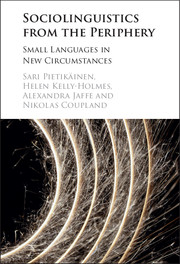Book contents
- Sociolinguistics from the Periphery
- Sociolinguistics from the Periphery
- Copyright page
- Contents
- Figures
- Tables
- Preface
- 1 Small languages in new circumstances?
- 2 Reflexivity and small languages
- 3 Conventional and transactional authenticities in small-culture tourism
- 4 Expanding possibilities for commodification
- 5 Transgression, small languages and changing boundaries
- 6 A view from the periphery
- References
- Index
- References
References
Published online by Cambridge University Press: 05 May 2016
- Sociolinguistics from the Periphery
- Sociolinguistics from the Periphery
- Copyright page
- Contents
- Figures
- Tables
- Preface
- 1 Small languages in new circumstances?
- 2 Reflexivity and small languages
- 3 Conventional and transactional authenticities in small-culture tourism
- 4 Expanding possibilities for commodification
- 5 Transgression, small languages and changing boundaries
- 6 A view from the periphery
- References
- Index
- References
- Type
- Chapter
- Information
- Sociolinguistics from the PeripherySmall Languages in New Circumstances, pp. 208 - 225Publisher: Cambridge University PressPrint publication year: 2016



